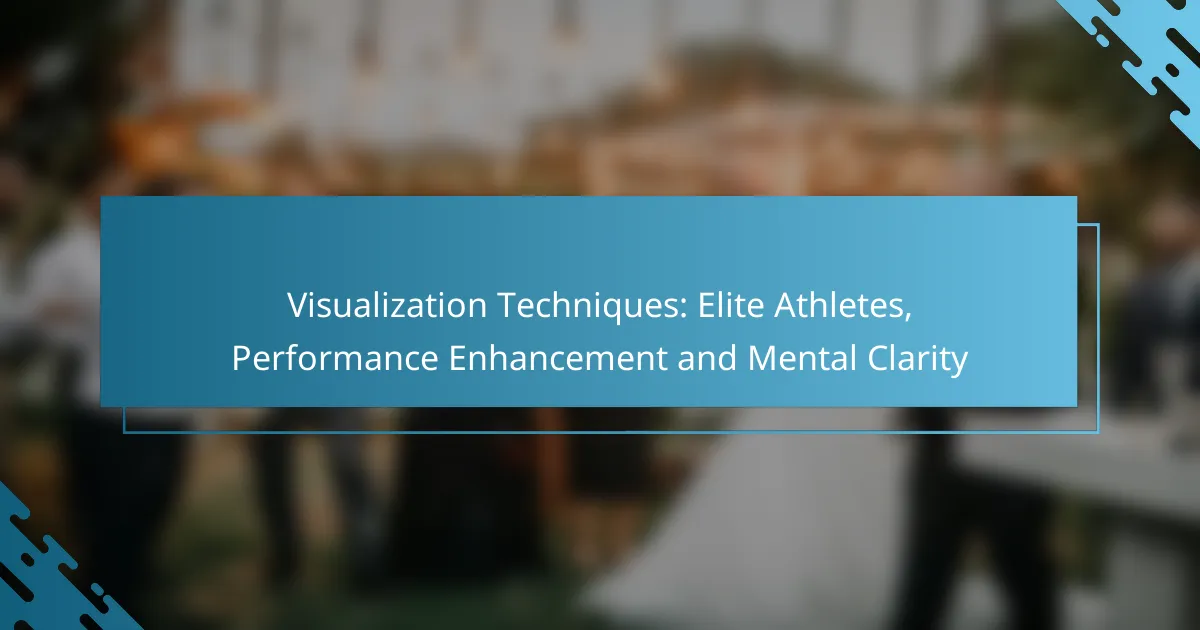Visualization techniques play a crucial role in enhancing the performance of elite athletes by enabling them to mentally rehearse their actions, which fosters improved focus and confidence. By employing methods such as guided imagery and self-talk visualization, athletes can create vivid mental images that prepare their minds and bodies for competition, ultimately leading to greater effectiveness and mental clarity.
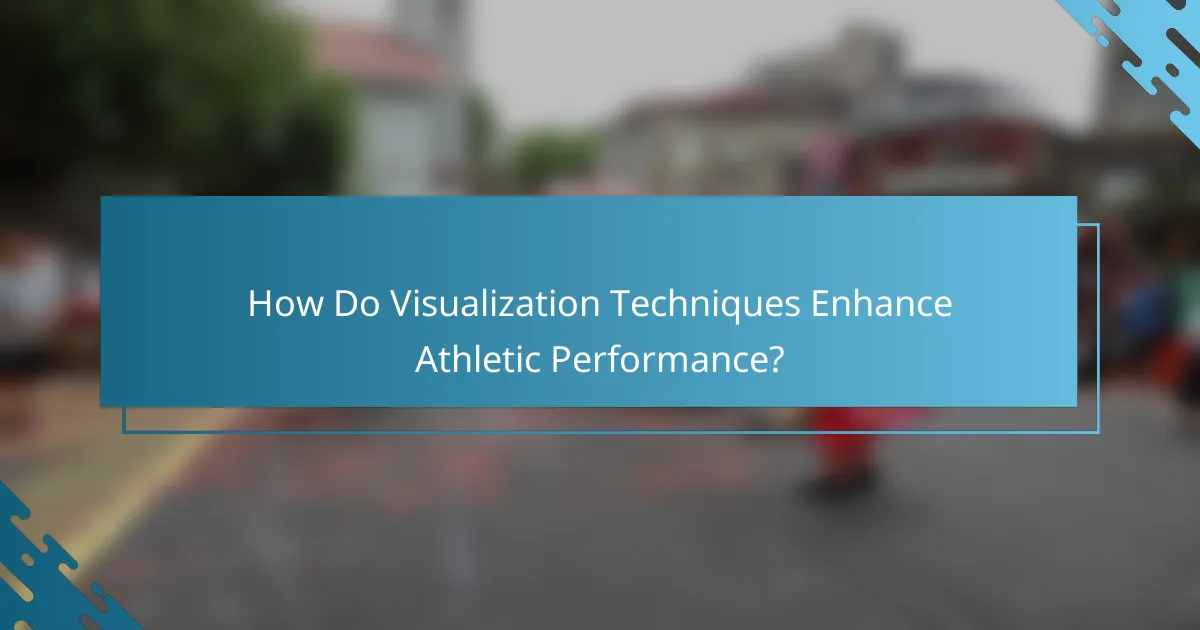
How Do Visualization Techniques Enhance Athletic Performance?
Visualization techniques enhance athletic performance by allowing athletes to mentally rehearse their actions, leading to improved focus, confidence, and execution of skills. By creating vivid mental images of their performance, athletes can prepare their minds and bodies for competition, ultimately boosting their overall effectiveness.
Improved focus and concentration
Visualization helps athletes sharpen their focus and concentration by training their minds to eliminate distractions. By regularly practicing mental imagery, athletes can simulate the competitive environment, which conditions them to maintain attention on their performance during actual events.
To enhance focus, athletes should set aside time daily for visualization, ideally in a quiet space. They can visualize specific scenarios, such as executing a perfect routine or overcoming obstacles, which reinforces their ability to concentrate under pressure.
Increased confidence and motivation
Visualization techniques can significantly boost an athlete’s confidence and motivation by allowing them to envision success. By repeatedly imagining themselves achieving their goals, athletes build a positive mindset that translates into real-world performance.
To harness this benefit, athletes should visualize not only their successes but also their progress and improvements. This practice can help them stay motivated, especially during challenging training periods or when facing setbacks.
Enhanced muscle memory and skill execution
Visualization can enhance muscle memory and skill execution by reinforcing the neural pathways associated with specific movements. When athletes visualize their techniques, they mentally practice the motions, which can lead to better coordination and execution during actual performance.
For effective muscle memory enhancement, athletes should combine visualization with physical practice. This dual approach allows them to mentally rehearse skills before executing them, ensuring that their body responds instinctively during competition.

Which Visualization Techniques Are Most Effective for Elite Athletes?
Effective visualization techniques for elite athletes include guided imagery, video modeling, and self-talk visualization. These methods enhance performance by improving mental clarity and focus, enabling athletes to mentally rehearse their skills and strategies.
Guided imagery
Guided imagery involves creating detailed mental images of successful performance scenarios. Athletes often use this technique to visualize themselves executing skills flawlessly, which can enhance confidence and reduce anxiety.
To practice guided imagery, athletes should find a quiet space, close their eyes, and vividly imagine the sights, sounds, and feelings associated with their sport. Regular sessions can lead to improved mental readiness and performance consistency.
Video modeling
Video modeling uses recorded footage of successful performances to help athletes visualize techniques and strategies. This method allows athletes to observe and mentally replicate the actions of elite performers, reinforcing proper mechanics and tactics.
When utilizing video modeling, athletes should focus on specific aspects of the performance, such as body positioning or timing. Watching these videos multiple times can deepen understanding and enhance muscle memory.
Self-talk visualization
Self-talk visualization combines positive affirmations with mental imagery to boost motivation and focus. Athletes use this technique to reinforce their belief in their abilities, helping to create a positive mindset before competitions.
To implement self-talk visualization, athletes should develop a set of affirmations that resonate with their goals and visualize themselves achieving those goals while repeating the affirmations. This practice can help mitigate negative thoughts and enhance overall performance.
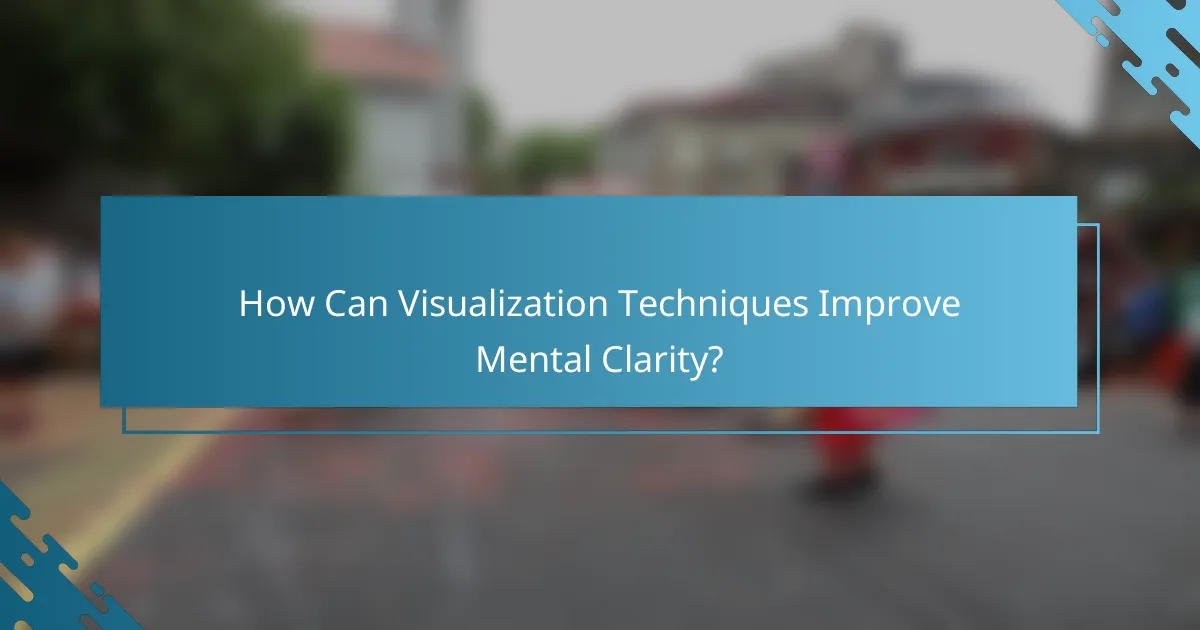
How Can Visualization Techniques Improve Mental Clarity?
Visualization techniques can significantly enhance mental clarity by allowing athletes to mentally rehearse their performance, leading to improved focus and concentration. This practice helps in creating a clear mental image of desired outcomes, which can reduce distractions and enhance overall performance.
Reduction of anxiety and stress
Visualization can effectively reduce anxiety and stress by providing athletes with a mental escape and a sense of control over their performance. By picturing successful outcomes, athletes can diminish negative thoughts and feelings that often accompany high-pressure situations.
To implement this, athletes can spend a few minutes each day visualizing themselves succeeding in their sport, which can help lower cortisol levels and promote a calmer mindset. Techniques such as deep breathing combined with visualization can further enhance this effect.
Enhanced decision-making skills
Visualization techniques can improve decision-making skills by allowing athletes to mentally simulate various scenarios they may encounter during competition. This mental practice helps in recognizing patterns and making quicker, more informed choices in real-time situations.
Athletes can benefit from visualizing different game strategies or responses to opponents’ moves, which prepares them for unexpected challenges. Regular practice can lead to a more intuitive understanding of their sport, enhancing their ability to make split-second decisions effectively.
Improved emotional regulation
Visualization aids in emotional regulation by helping athletes manage their feelings during competitions. By envisioning themselves handling pressure and maintaining composure, they can build resilience against emotional disturbances that may arise during performance.
Practicing visualization techniques that focus on positive emotional states, such as confidence and calmness, can help athletes develop a toolkit for managing their emotions. This proactive approach can lead to better performance outcomes and a more enjoyable experience in their sport.
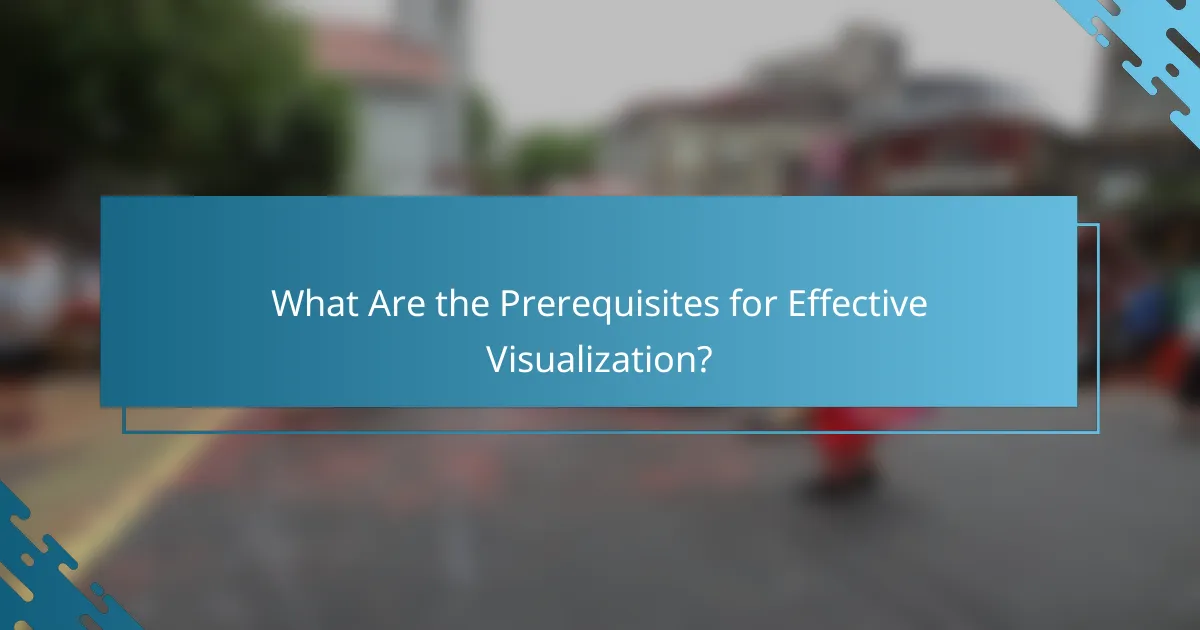
What Are the Prerequisites for Effective Visualization?
Effective visualization requires a clear understanding of one’s goals and consistent practice. These elements help athletes harness mental imagery to enhance performance and achieve mental clarity.
Clear goals and objectives
Establishing clear goals and objectives is essential for effective visualization. Athletes should define specific, measurable outcomes they wish to achieve, such as improving their sprint time or mastering a particular technique. This clarity allows for focused mental imagery that aligns with their performance aspirations.
For instance, instead of a vague goal like “get better at swimming,” an athlete might set a target to “reduce 100-meter freestyle time by two seconds.” This specificity guides the visualization process, making it more impactful.
Consistent practice and repetition
Consistent practice and repetition are crucial for embedding visualization techniques into an athlete’s routine. Regularly engaging in mental imagery helps reinforce the neural pathways associated with the desired performance. Athletes should aim to visualize their goals daily, ideally integrating this practice into their training sessions.
A practical approach is to dedicate 10-15 minutes each day to visualization exercises, where athletes mentally rehearse their performance in various scenarios. This repetition not only enhances familiarity but also builds confidence, making the visualization more effective during actual competition.
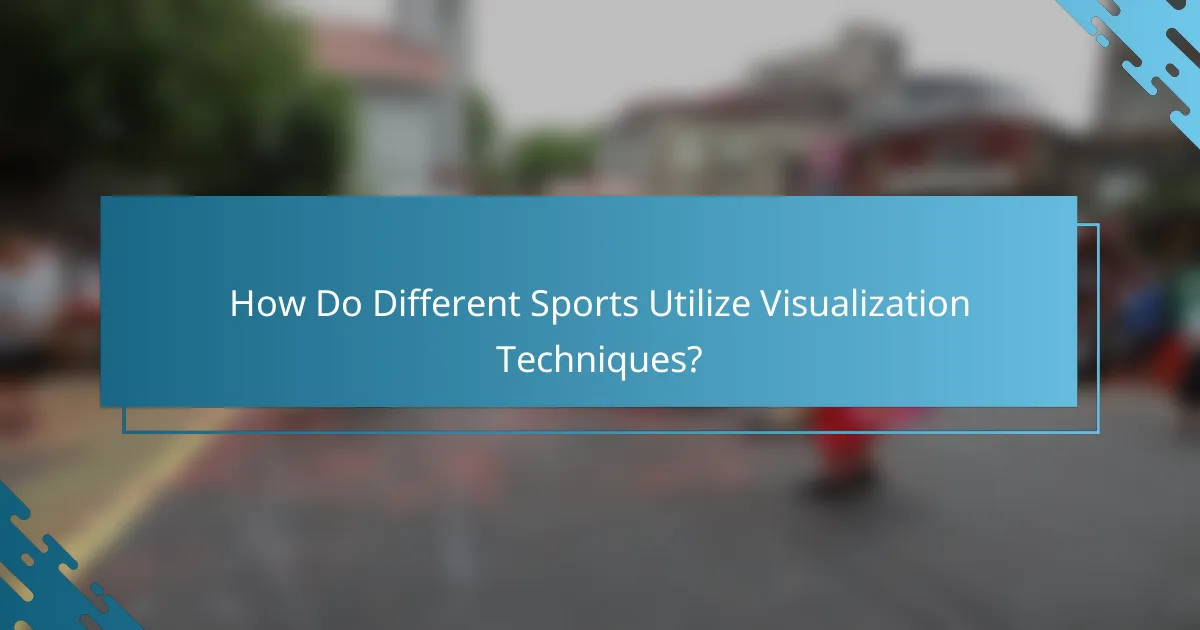
How Do Different Sports Utilize Visualization Techniques?
Different sports employ visualization techniques to enhance performance, improve focus, and boost mental clarity. These methods vary significantly between team and individual sports, reflecting the unique demands and dynamics of each type.
Visualization in team sports
In team sports, visualization often focuses on strategic plays and teamwork dynamics. Athletes visualize game scenarios to enhance communication and coordination with teammates, which can lead to improved execution during actual games.
For example, a basketball player might mentally rehearse a specific play, visualizing their movements and those of their teammates. This technique helps athletes anticipate actions and react more effectively during high-pressure situations.
Common pitfalls include overthinking or becoming too rigid in their mental imagery, which can hinder adaptability. Athletes should practice flexibility in their visualizations to account for the unpredictable nature of team dynamics.
Visualization in individual sports
Individual sports utilize visualization to enhance personal performance and mental resilience. Athletes often visualize their routines, techniques, and even the emotions they will experience during competition, which can help build confidence and reduce anxiety.
For instance, a sprinter might visualize the start of a race, imagining the sound of the starting gun and the feeling of their legs propelling them forward. This mental rehearsal can lead to improved focus and execution on race day.
It’s crucial for athletes in individual sports to avoid becoming overly reliant on visualization alone. Balancing mental imagery with physical practice ensures that athletes remain grounded and prepared for competition. Regularly updating and refining their visualizations can also keep them aligned with their evolving goals and techniques.
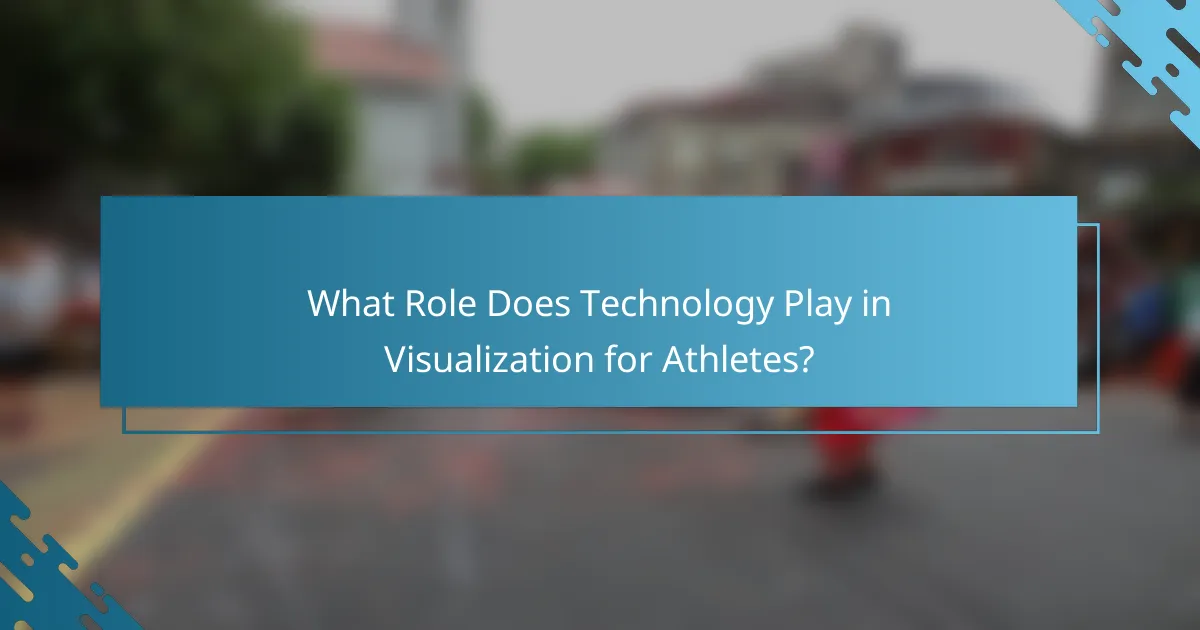
What Role Does Technology Play in Visualization for Athletes?
Technology significantly enhances visualization techniques for athletes by providing immersive experiences that improve mental preparation and performance. Tools like virtual reality and biofeedback systems allow athletes to visualize scenarios, refine skills, and develop mental clarity effectively.
Virtual reality training
Virtual reality (VR) training immerses athletes in lifelike environments where they can practice skills and strategies without physical exertion. This technology creates realistic simulations that help athletes visualize their performance in various scenarios, from game situations to specific skill drills.
When using VR, athletes can focus on their technique and decision-making processes in a controlled setting. This method is particularly beneficial for sports that require quick reactions and strategic thinking, such as basketball or soccer. For instance, a basketball player can practice shooting under pressure by simulating a game environment.
To maximize the benefits of VR training, athletes should ensure they use high-quality equipment and software tailored to their sport. Regular sessions, ideally a few times a week, can lead to significant improvements in mental clarity and performance. However, it’s crucial to balance VR training with actual physical practice to maintain overall skill development.
